Real-Time Life-Cycle Monitoring of Composite Structures Using Piezoelectric-Fiber Hybrid Sensor Network
Abstract
:1. Introduction
2. Cure Monitoring
2.1. Experimental Setup for Cure Monitoring
2.2. DMA Test
2.3. Results and Discussion of the Cure Monitoring Process
3. Service Monitoring
3.1. Probability Damage Imaging with the Averaged Shape Factor
3.2. Probability Damage Imaging with the Dynamically Adaptive Shape Factor
4. Conclusions
Author Contributions
Funding
Institutional Review Board Statement
Informed Consent Statement
Data Availability Statement
Acknowledgments
Conflicts of Interest
References
- Qing, X.; Liu, X.; Zhu, J.; Wang, Y. In-situ monitoring of liquid composite molding process using piezoelectric sensor network. Struct. Health Monit. 2020, 3, 1–13. [Google Scholar] [CrossRef]
- Li, J.; Yu, Y.; Qing, X. Embedded FBG Sensor Based Impact Identification of CFRP Using Ensemble Learning. Sensors 2021, 21, 1452. [Google Scholar] [CrossRef] [PubMed]
- Mizukami, K.; Ikeda, T.; Ogi, K. Measurement of velocity and attenuation of ultrasonic guided wave for real-time estimation of cure-dependent anisotropic viscoelastic properties of carbon fiber-reinforced plastics. Ultrasonics 2019, 99, 105952. [Google Scholar] [CrossRef] [PubMed]
- Chen, J.; Wang, J.; Li, X.; Sun, L.; Li, S.; Ding, A. Monitoring of temperature and cure-induced strain gradient in laminated composite plate with FBG sensors. Compos. Struct. 2020, 242, 112168. [Google Scholar] [CrossRef]
- Mizukami, K.; Yoshimoto, S.; Ogi, K. In-process acquisition of cure-dependent viscoelastic properties of carbon fiber reinforced composites using micromechanics-based guided wave analysis. Polym. Test. 2018, 65, 459–467. [Google Scholar] [CrossRef]
- Liu, X.; Li, J.; Zhu, J.; Wang, Y.; Qing, X. Cure monitoring and damage identification of CFRP using embedded piezoelectric sensors network. Ultrasonics 2021, 115, 106470. [Google Scholar] [CrossRef] [PubMed]
- Borrero, E.L.S.; Farhangi, V.; Jadidi, K.; Karakouzian, M. An Experimental Study on Concrete’s Durability and Mechanical Characteristics Subjected to Different Curing Regimes. Civ. Eng. J. 2021, 7, 676–689. [Google Scholar] [CrossRef]
- Daneshvar, K.; Moradi, M.J.; Ahmadi, K.; Hajiloo, H. Strengthening of corroded reinforced concrete slabs under multi-impact loading: Experimental results and numerical analysis. Constr. Build. Mater. 2021, 284, 122650. [Google Scholar] [CrossRef]
- Khedmatgozar Dolati, S.S.; Caluk, N.; Mehrabi, A.; Khedmatgozar Dolati, S.S. Non-Destructive Testing Applications for Steel Bridges. Appl. Sci. 2021, 11, 9757. [Google Scholar] [CrossRef]
- Rufai, O.; Chandarana, N.; Gautam, M.; Potluri, P.; Gresil, M. Cure monitoring and structural health monitoring of composites using micro-braided distributed optical fibre. Compos. Struct. 2020, 254, 112861. [Google Scholar] [CrossRef]
- Hu, H.; Li, S.; Wang, J.; Zu, L.; Cao, D.; Zhong, Y. Monitoring the gelation and effective chemical shrinkage of composite curing process with a novel FBG approach. Compos. Struct. 2017, 176, 187–194. [Google Scholar] [CrossRef]
- Mulle, M.; Wafai, H.; Yudhanto, A.; Lubineau, G.; Yaldiz, R.; Schijve, W.; Verghese, N. Process monitoring of glass reinforced polypropylene laminates using fiber Bragg gratings. Compos. Sci. Technol. 2016, 123, 143–150. [Google Scholar] [CrossRef]
- Sampath, U.; Kim, H.; Kim, D.G.; Kim, Y.C.; Song, M. In-Situ Cure Monitoring of Wind Turbine Blades by Using Fiber Bragg Grating Sensors and Fresnel Reflection Measurement. Sensors 2015, 15, 18229–18238. [Google Scholar] [CrossRef] [PubMed] [Green Version]
- Scholle, P.; Sinapius, M. Pulse Ultrasonic Cure Monitoring of the Pultrusion Process. Sensors 2018, 18, 3332. [Google Scholar] [CrossRef] [PubMed] [Green Version]
- Lionetto, F.; Maffezzoli, A. Monitoring the Cure State of Thermosetting Resins by Ultrasound. Materials 2013, 6, 3783–3804. [Google Scholar] [CrossRef]
- Li, F.; Murayama, H.; Kageyama, K.; Shirai, T. Guided wave and damage detection in composite laminates using different fiber optic sensors. Sensors 2009, 9, 4005–4021. [Google Scholar] [CrossRef] [PubMed]
- Pavlopoulou, S.; Soutis, C.; Staszewski, W.J. Cure monitoring through time–frequency analysis of guided ultrasonic waves. Plast. Rubber Compos. 2013, 41, 180–186. [Google Scholar] [CrossRef]
- Lim, Y.Y.; Tang, Z.S.; Smith, S.T. Piezoelectric-based monitoring of the curing of structural adhesives: A novel experimental study. Smart Mater. Struct. 2019, 28, 015016. [Google Scholar] [CrossRef]
- Zhang, M.; Bareille, O.; Salvia, M. Cure and damage monitoring of flax fiber-reinforced epoxy composite repairs for civil engineering structures using embedded piezo micro-patches. Constr. Build. Mater. 2019, 225, 196–203. [Google Scholar] [CrossRef]
- Malinowski, P.; Wandowski, T.; Ostachowicz, W. The use of electromechanical impedance conductance signatures for detection of weak adhesive bonds of carbon fibre–reinforced polymer. Struct. Health Monit. 2015, 14, 332–344. [Google Scholar] [CrossRef]
- Nash, C.; Karve, P.; Adams, D.; Mahadevan, S.; Thorne, G. Real-time cure monitoring of fiber-reinforced polymer composites using infrared thermography and recursive Bayesian filtering. Compos. Part B Eng. 2020, 198, 108241. [Google Scholar] [CrossRef]
- Martens, U.; Schröder, K.U. Monitoring multiple damage mechanisms in crack-patched structures using optical infrared thermography. Fatigue Fract. Eng. Mater. Struct. 2020, 44, 705–718. [Google Scholar] [CrossRef]
- Danisman, M.; Tuncol, G.; Kaynar, A.; Sozer, E.M. Monitoring of resin flow in the resin transfer molding (RTM) process using point-voltage sensors. Compos. Sci. Technol. 2007, 67, 367–379. [Google Scholar] [CrossRef]
- Moghaddam, M.K.; Breede, A.; Brauner, C.; Lang, W. Embedding piezoresistive pressure sensors to obtain online pressure profiles inside fiber composite laminates. Sensors 2015, 15, 7499–7511. [Google Scholar] [CrossRef] [Green Version]
- Koissin, V.; Demčenko, A.; Korneev, V.A. Isothermal epoxy-cure monitoring using nonlinear ultrasonics. Int. J. Adhes. Adhes. 2014, 52, 11–18. [Google Scholar] [CrossRef]
- Khadka, S.; Hoffman, J.; Kumosa, M. FBG monitoring of curing in single fiber polymer composites. Compos. Sci. Technol. 2020, 198, 108308. [Google Scholar] [CrossRef]
- Minakuchi, S.; Takeda, N.; Takeda, S.-i.; Nagao, Y.; Franceschetti, A.; Liu, X. Life cycle monitoring of large-scale CFRP VARTM structure by fiber-optic-based distributed sensing. Compos. Part A Appl. Sci. Manuf. 2011, 42, 669–676. [Google Scholar] [CrossRef]
- Eum, S.H.; Kageyama, K.; Murayama, H.; Uzawa, K.; Ohsawa, I.; Kanai, M.; Kobayashi, S.; Igawa, H.; Shirai, T. Structural health monitoring using fiber optic distributed sensors for vacuum-assisted resin transfer molding. Smart Mater. Struct. 2007, 16, 2627–2635. [Google Scholar] [CrossRef]
- Nokhbatolfoghahai, A.; Navazi, H.M.; Groves, R.M. Using the hybrid DAS-SR method for damage localization in composite plates. Compos. Struct. 2020, 247, 112420. [Google Scholar] [CrossRef]
- Huang, L.; Zeng, L.; Lin, J. Baseline-free damage detection in composite plates based on the reciprocity principle. Smart Mater. Struct. 2018, 27, 015026. [Google Scholar] [CrossRef]
- Qing, X.; Li, W.; Wang, Y.; Sun, H. Piezoelectric Transducer-Based Structural Health Monitoring for Aircraft Applications. Sensors 2019, 19, 545. [Google Scholar] [CrossRef] [PubMed]
- Liu, K.; Ma, S.; Wu, Z.; Zheng, Y.; Qu, X.; Wang, Y.; Wu, W. A novel probability-based diagnostic imaging with weight compensation for damage localization using guided waves. Struct. Health Monit. Int. J. 2016, 15, 162–173. [Google Scholar] [CrossRef]
- Wu, Z.; Liu, K.; Wang, Y.; Zheng, Y. Validation and evaluation of damage identification using probability-based diagnostic imaging on a stiffened composite panel. J. Intell. Mater. Syst. Struct. 2014, 26, 2181–2195. [Google Scholar] [CrossRef]
- Wang, D.; Ye, L.; Su, Z.; Lu, Y.; Li, F.; Meng, G. Probabilistic Damage Identification Based on Correlation Analysis Using Guided Wave Signals in Aluminum Plates. Struct. Health Monit. 2010, 9, 133–144. [Google Scholar] [CrossRef]
- Jin, H.; Yan, J.; Liu, X.; Li, W.; Qing, X. Quantitative defect inspection in the curved composite structure using the modified probabilistic tomography algorithm and fusion of damage index. Ultrasonics 2021, 113, 106358. [Google Scholar] [CrossRef] [PubMed]
- Liu, Y.; Hong, X.; Zhang, B. A novel velocity anisotropy probability imaging method using ultrasonic guided waves for composite plates. Measurement 2020, 166, 108087. [Google Scholar] [CrossRef]
- Liu, X.; Li, Y.; Zhu, J.; Wang, Y.; Qing, X. Monitoring of resin flow front and degree of cure in vacuum-assisted resin infusion process using multifunctional piezoelectric sensor network. Polym. Compos. 2020, 42, 113–125. [Google Scholar] [CrossRef]
- Zhu, J.; Qing, X.; Liu, X.; Wang, Y. Electromechanical impedance-based damage localization with novel signatures extraction methodology and modified probability-weighted algorithm. Mech. Syst. Signal Process. 2021, 146, 107001. [Google Scholar] [CrossRef]
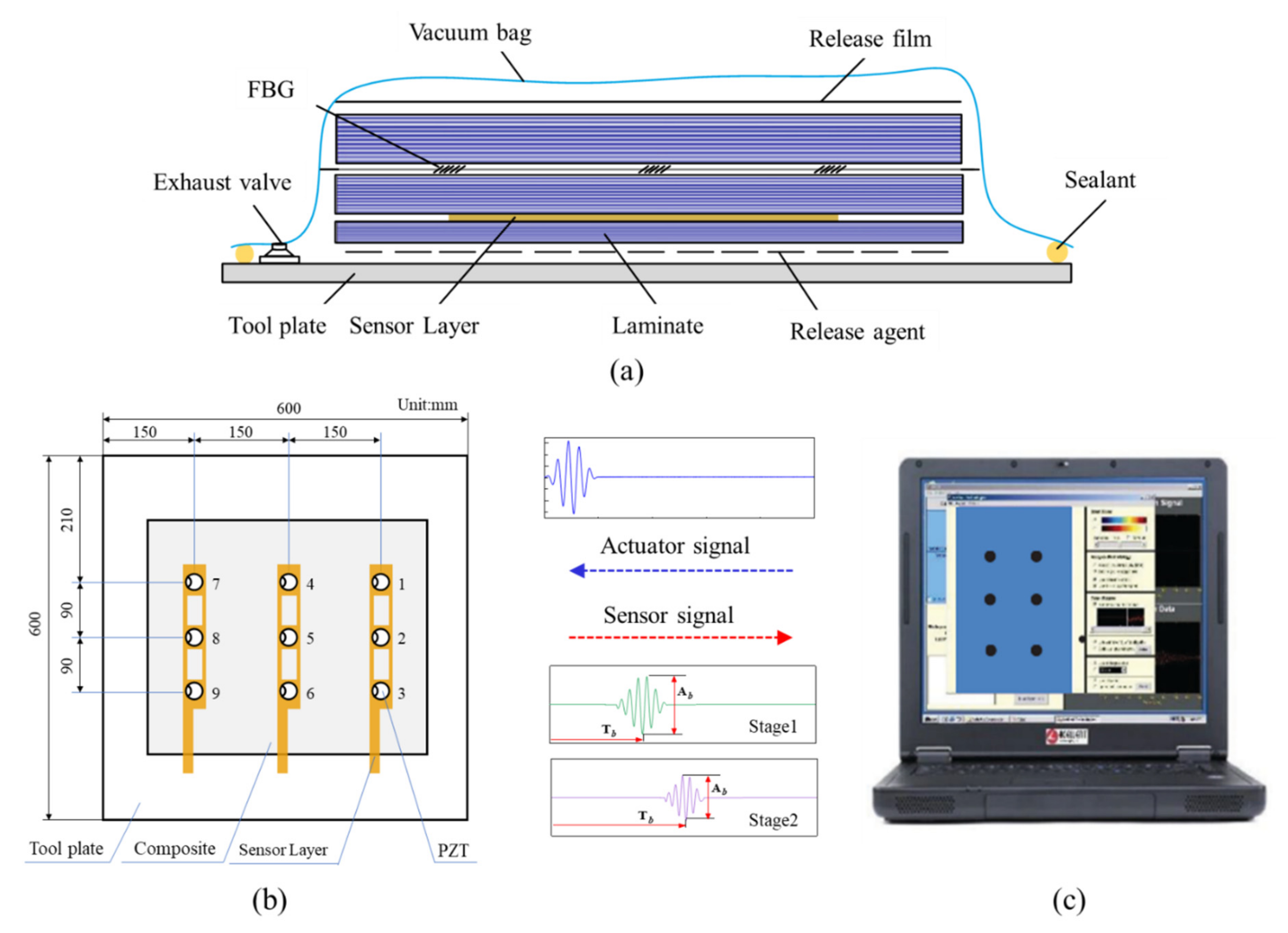
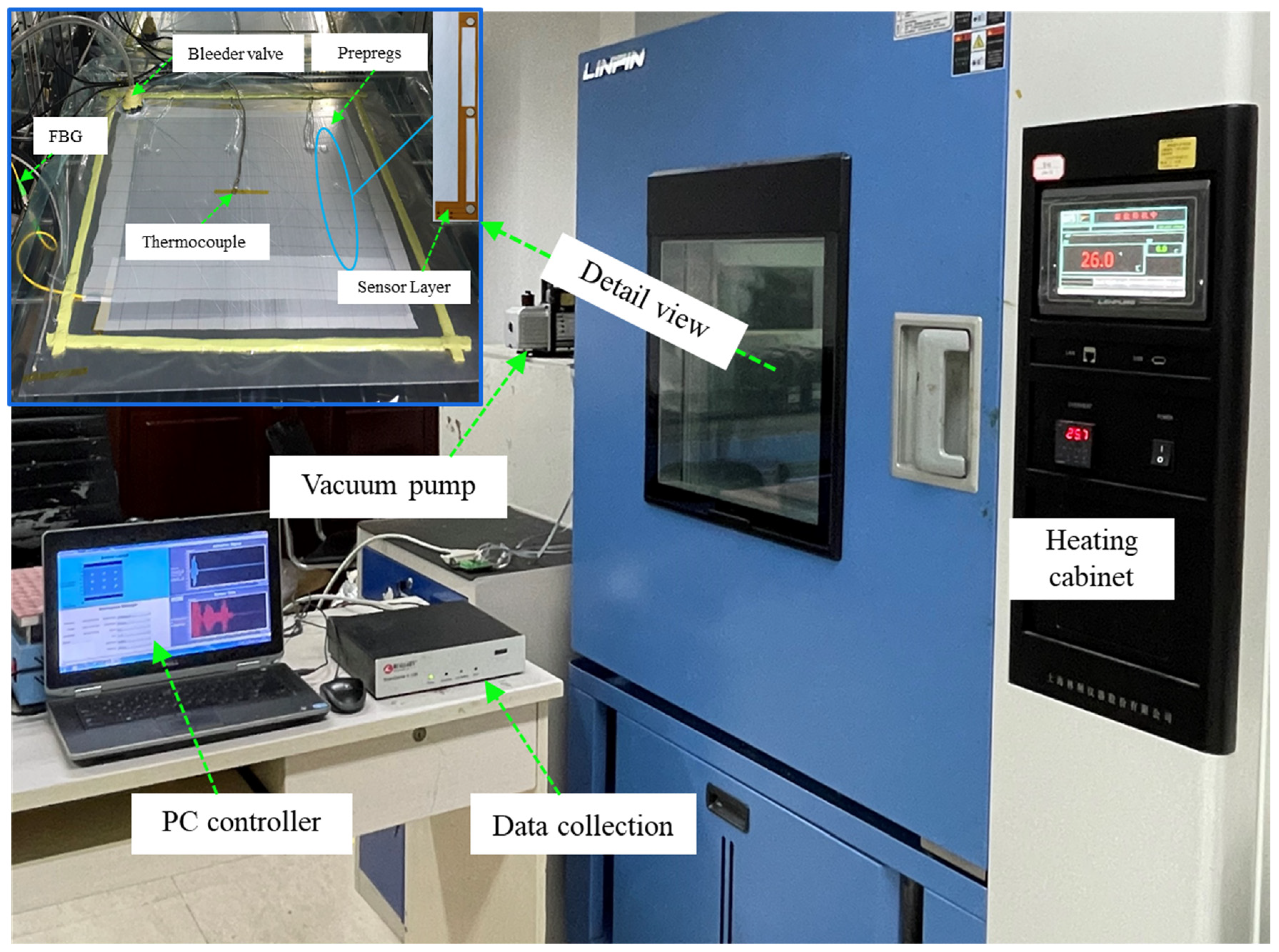



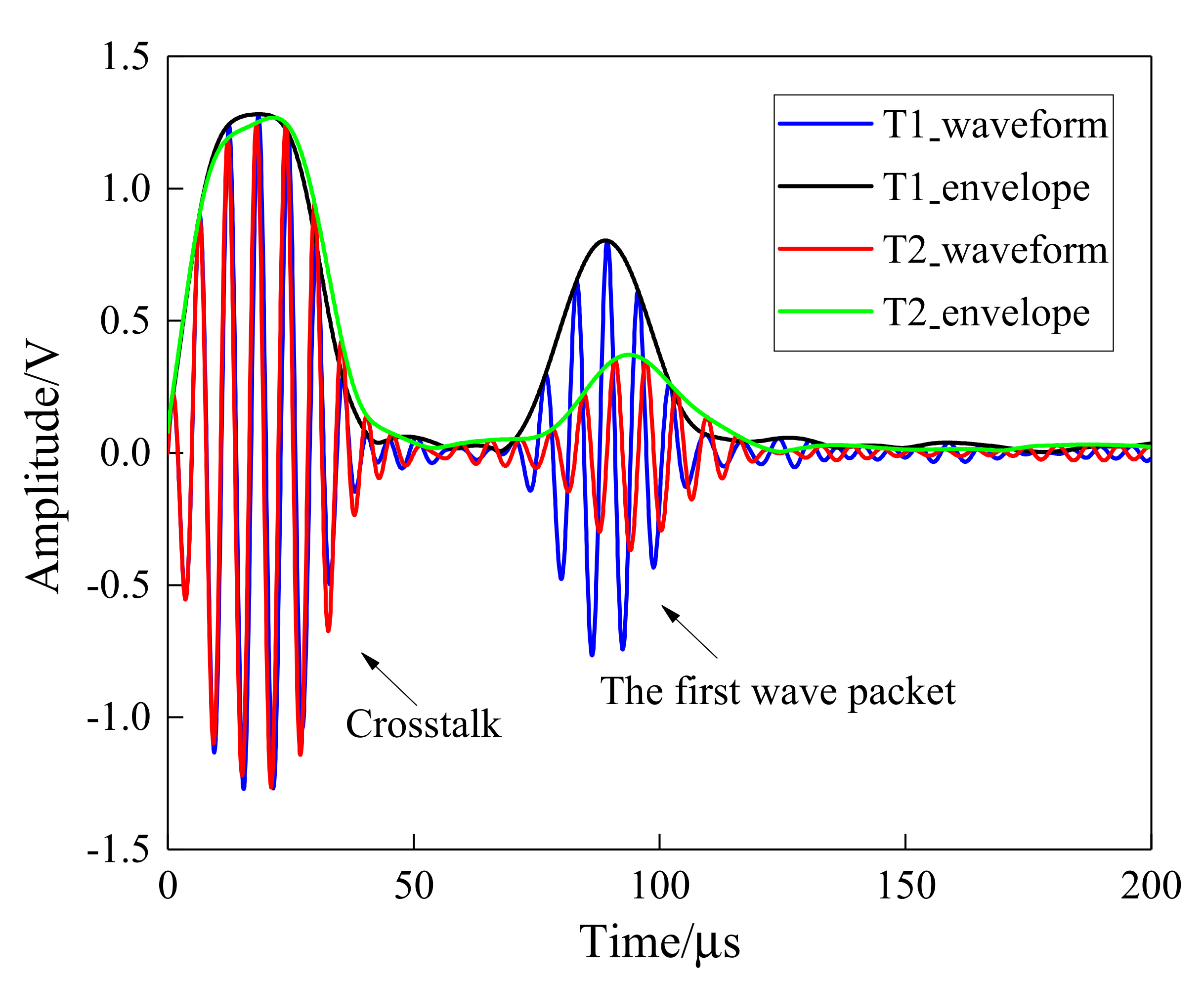
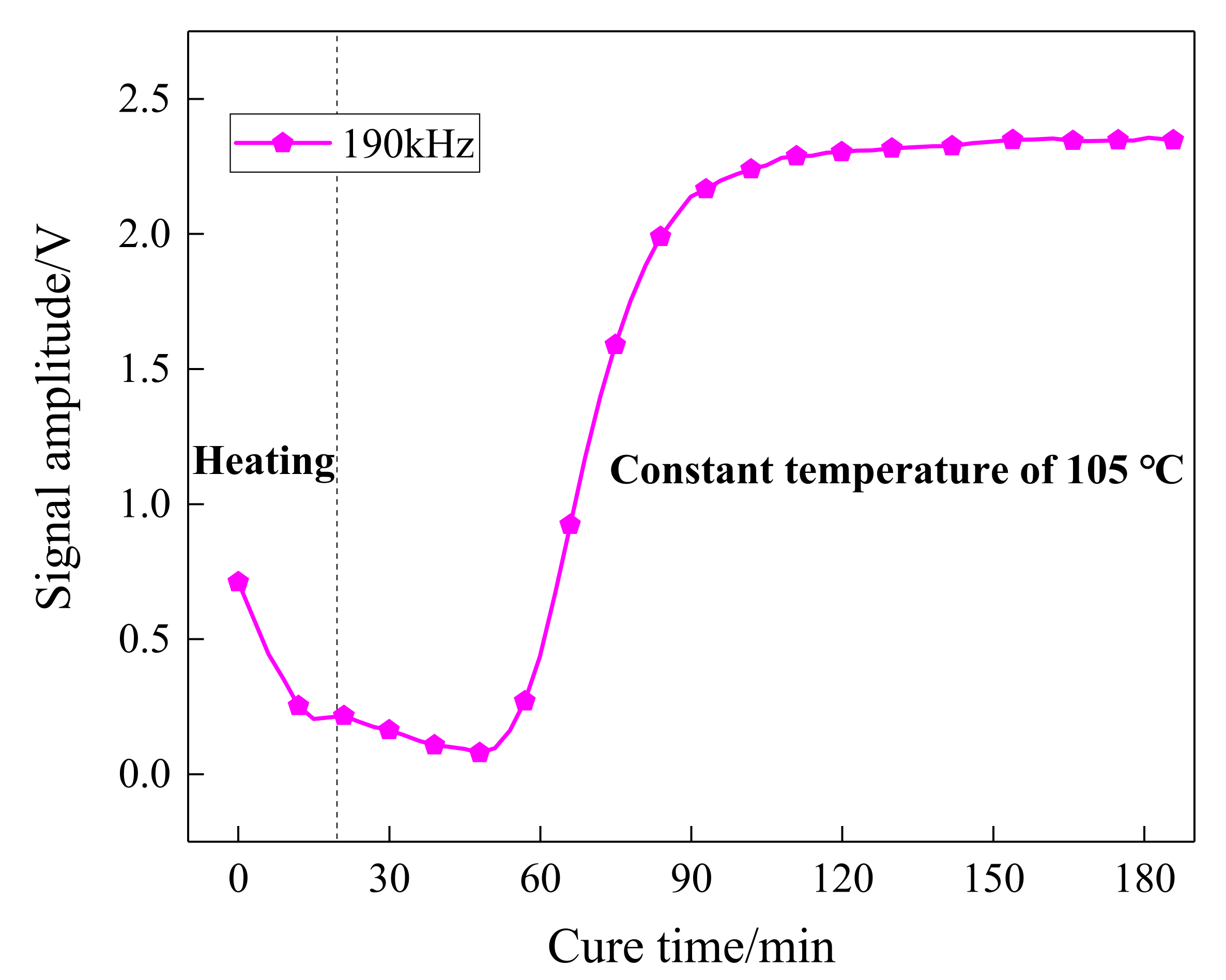
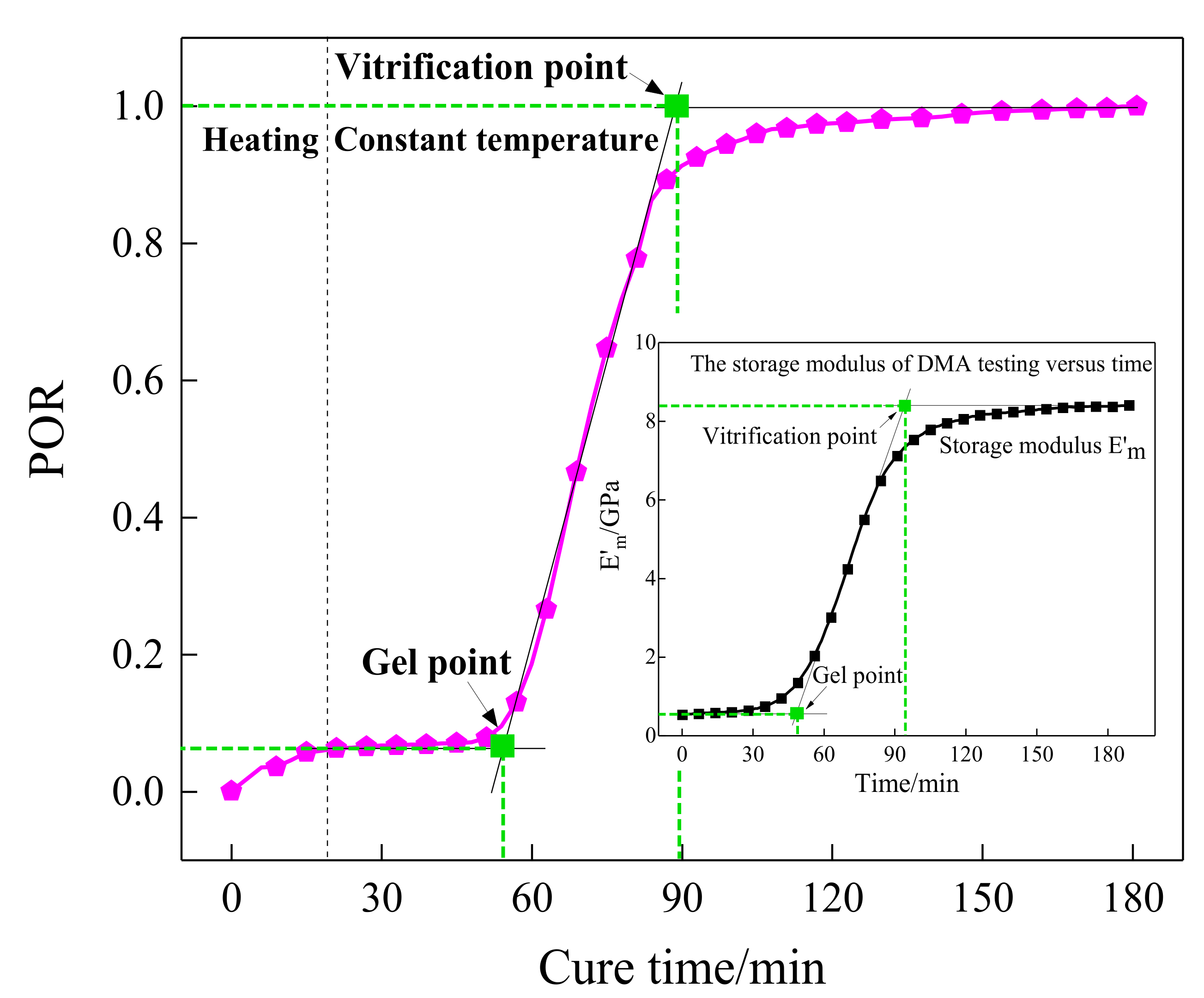

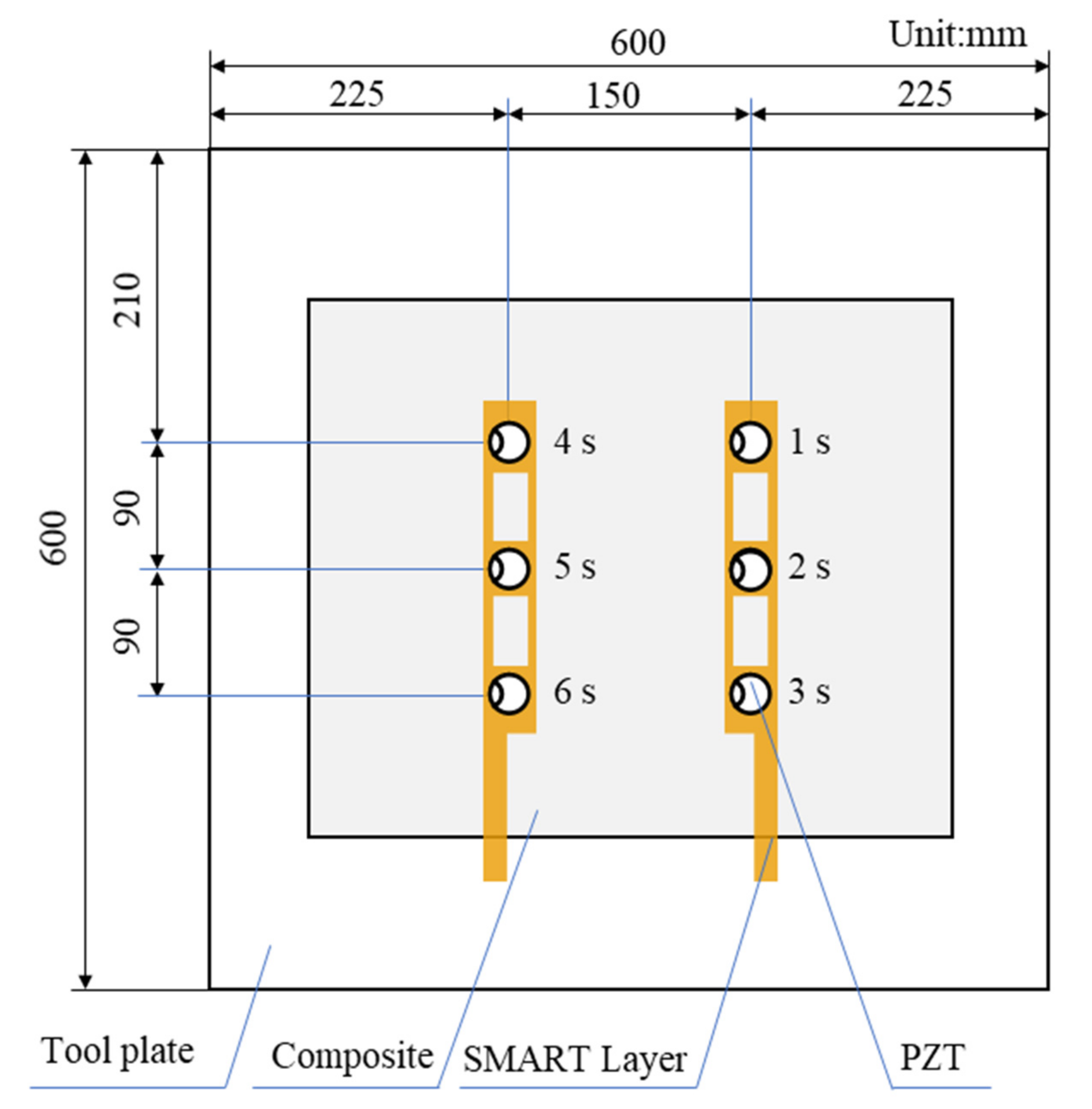

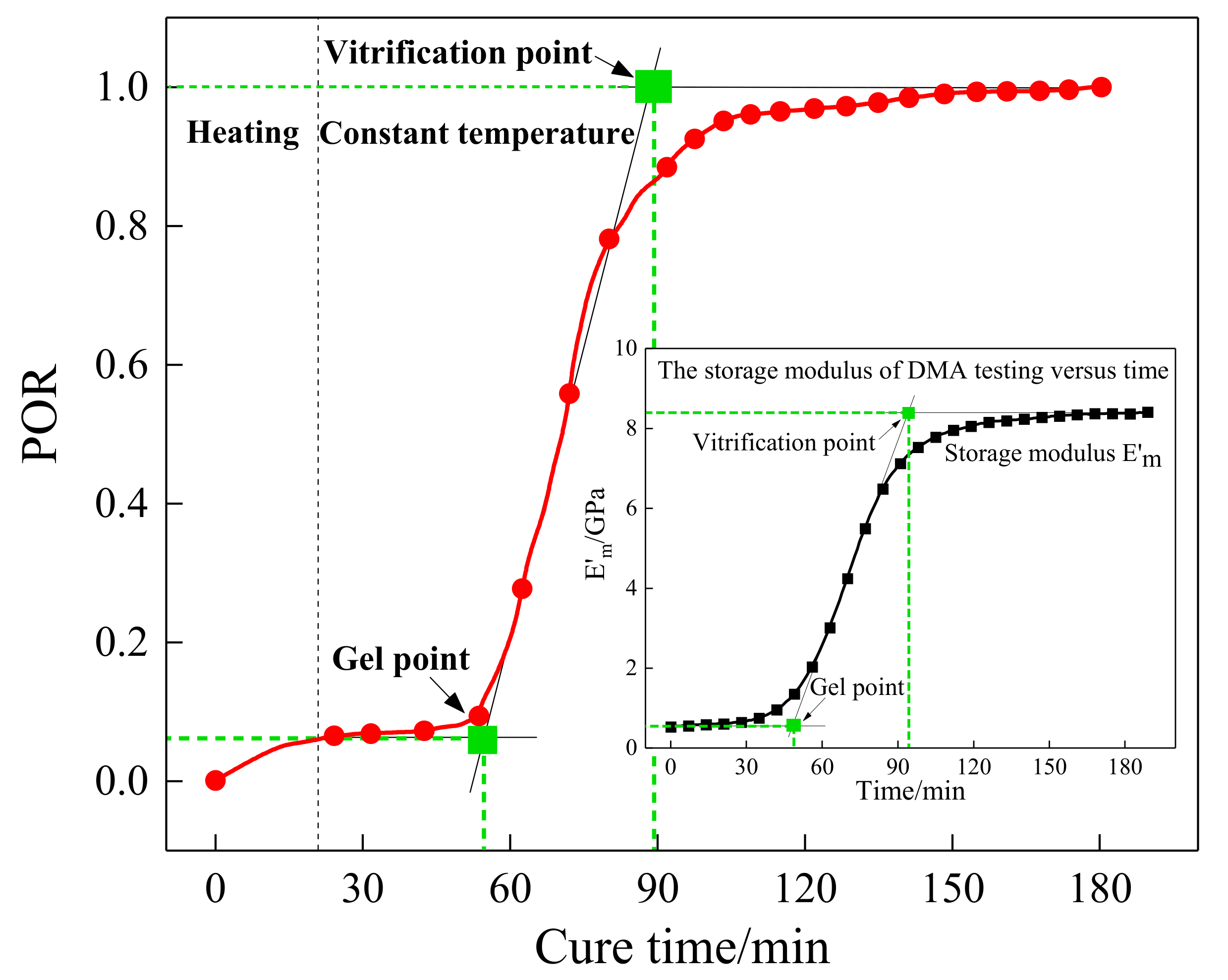
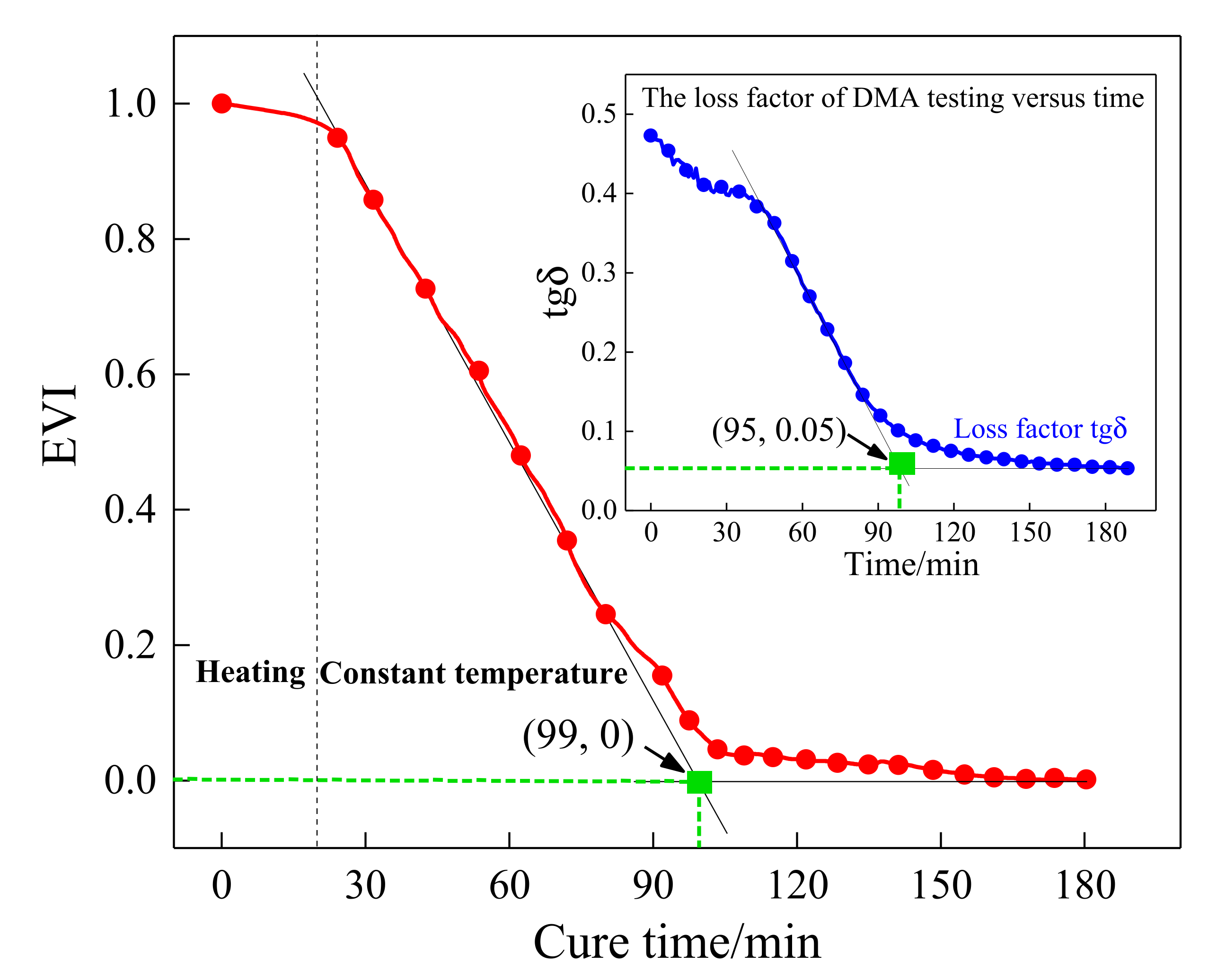
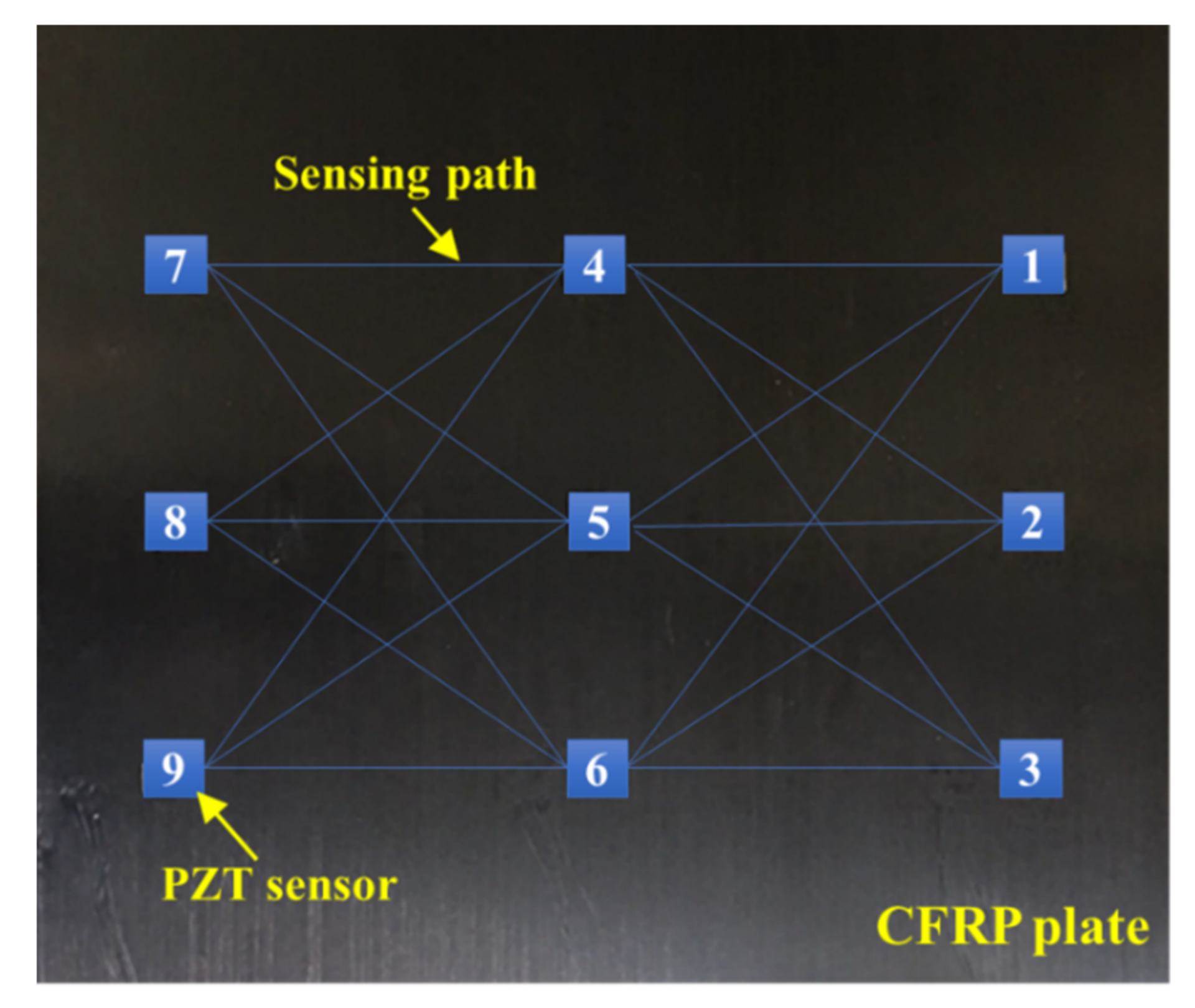
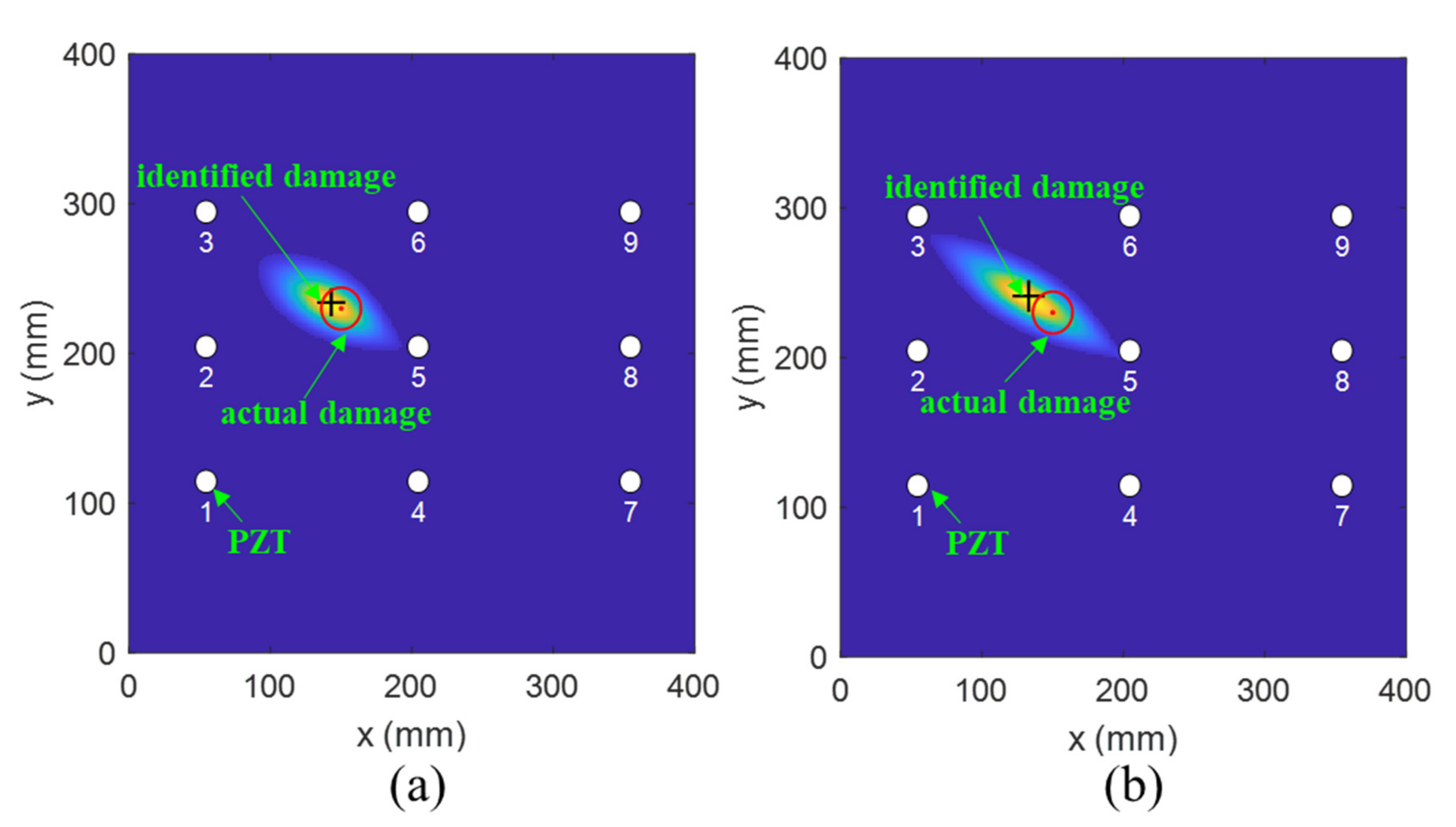

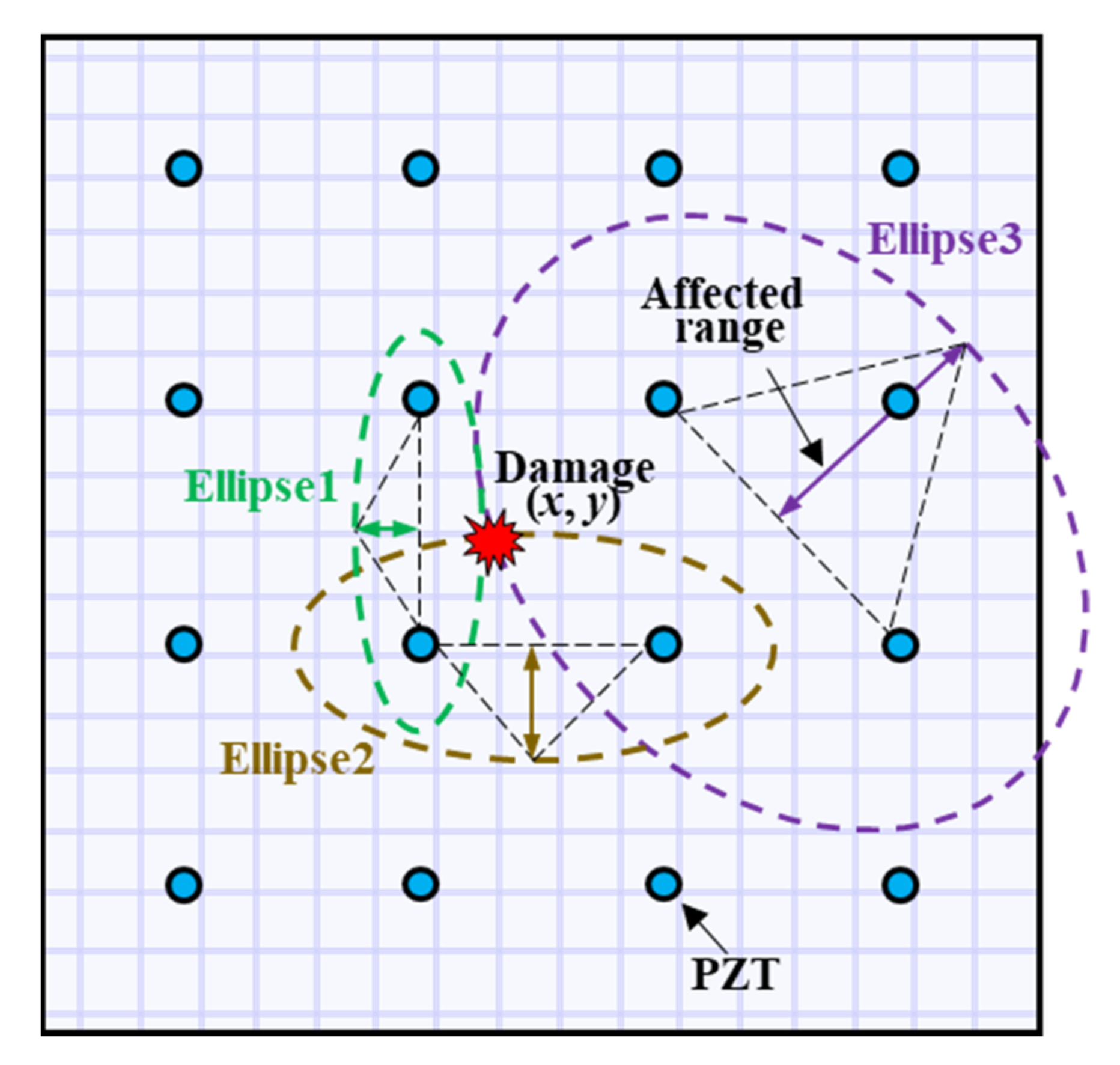
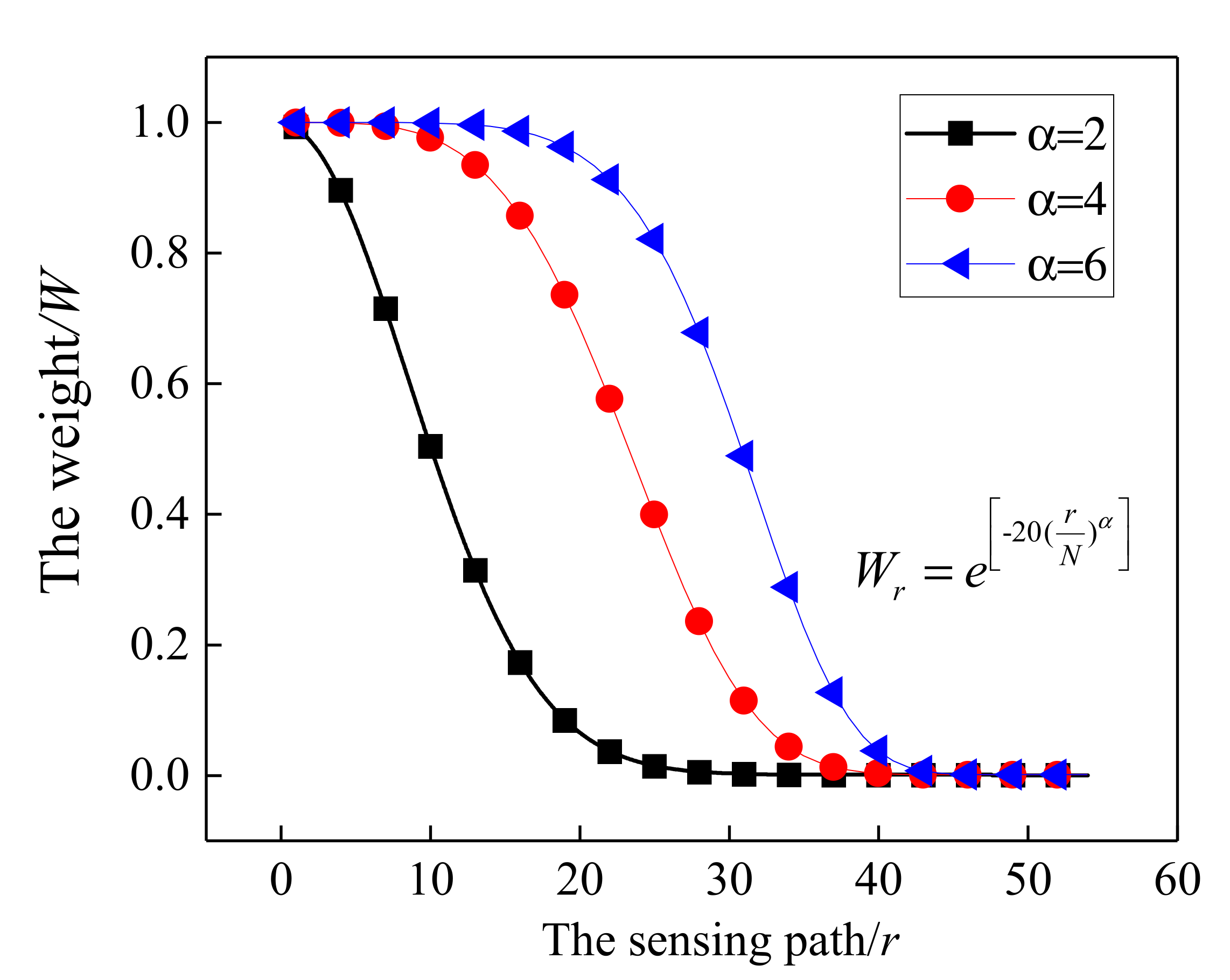
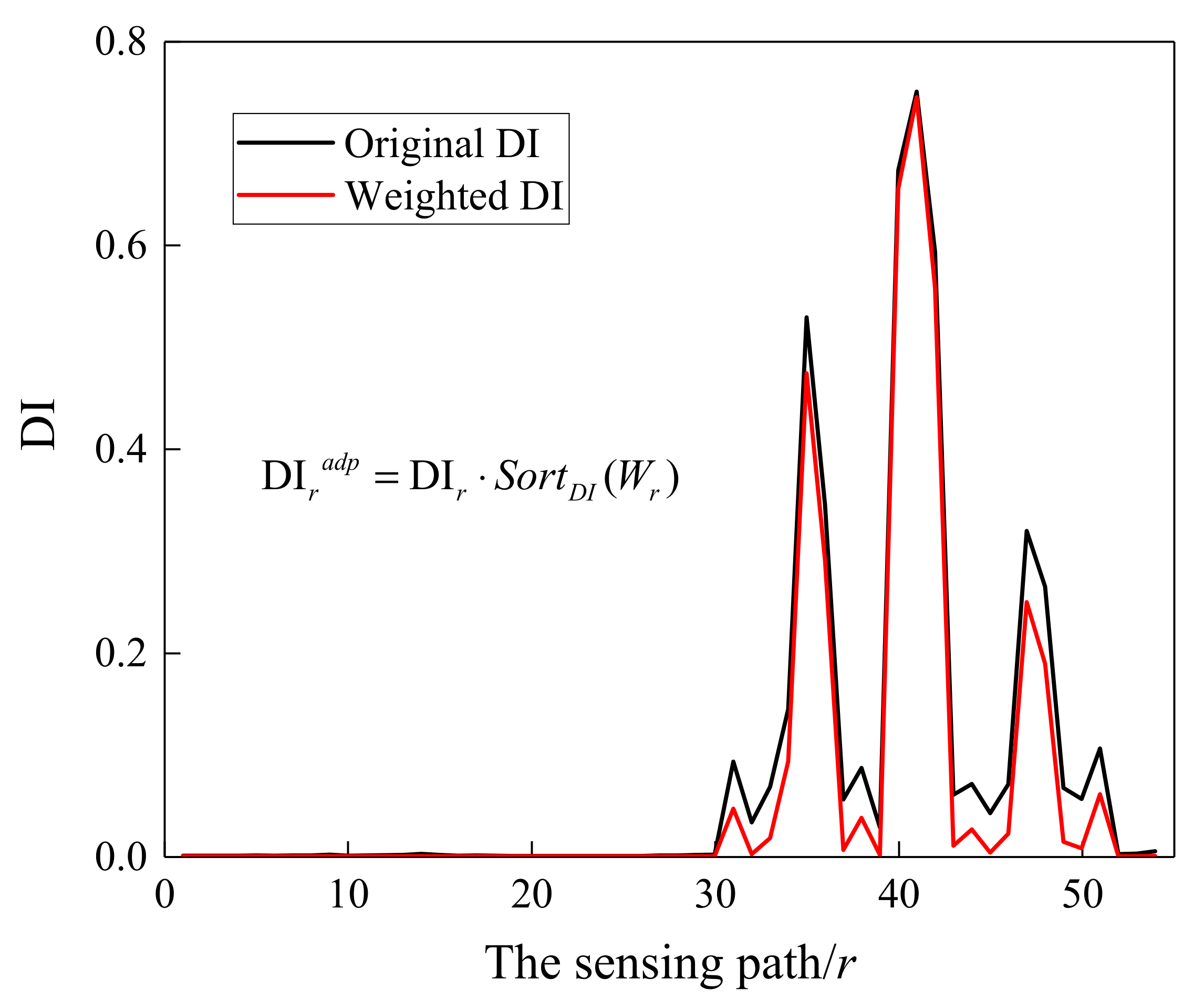
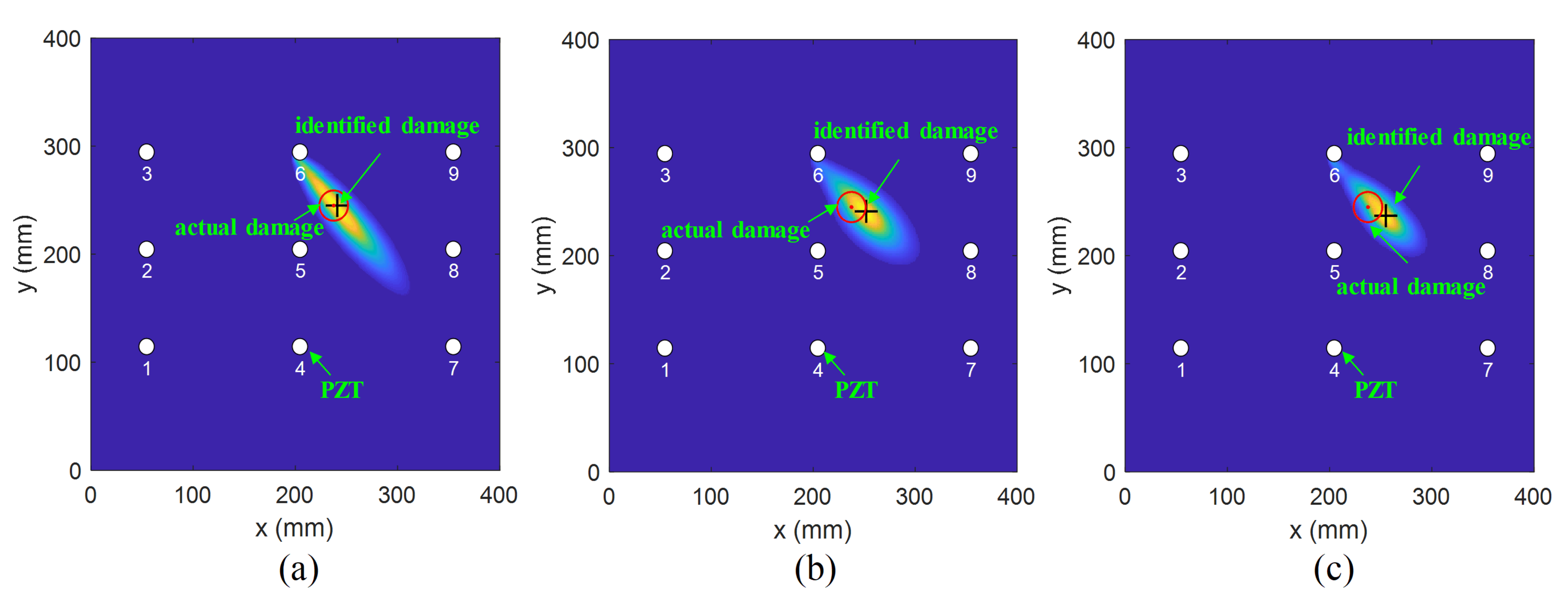

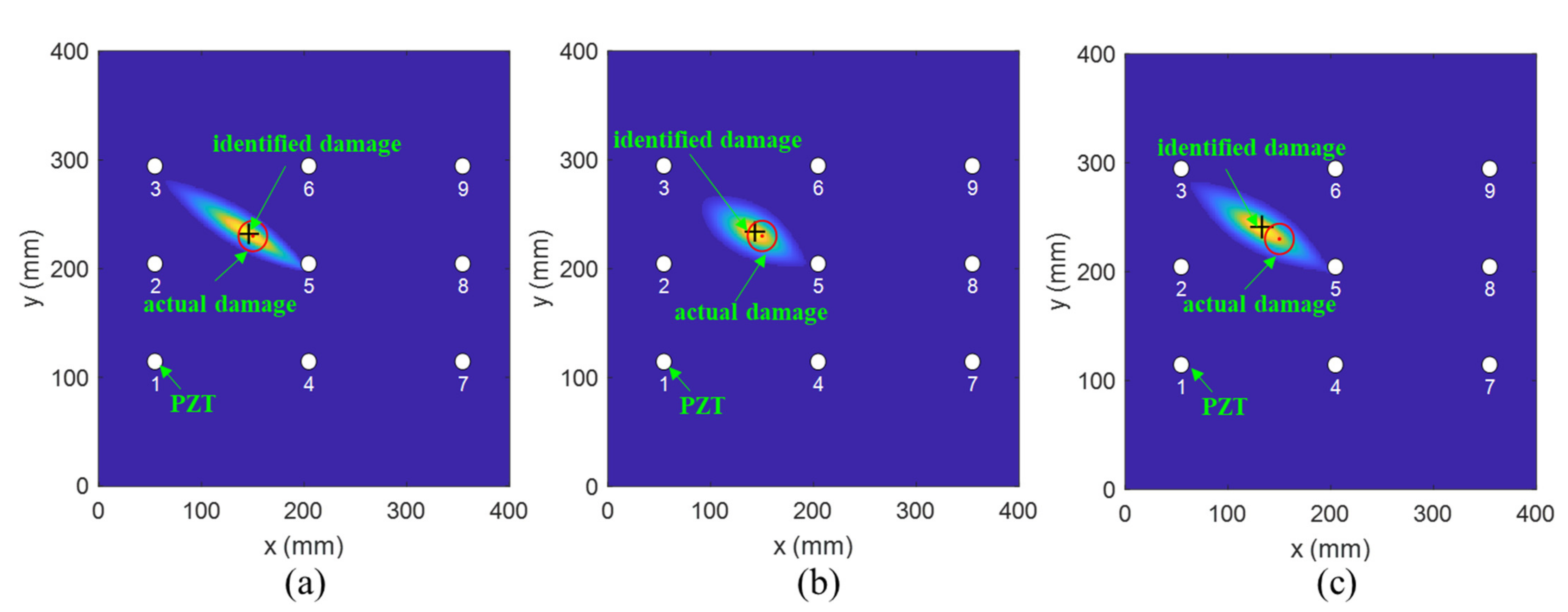
| Items. | Parameters | Values |
|---|---|---|
| s11E (×10−12 m2/N) | Compliance coefficient | 10.417 |
| s12E (×10−12 m2/N) | In-plane compliance coefficient | −3.333 |
| η | Mechanical loss factor | 0.025 |
| (Farad/m) | Relative dielectric constant | 1920 |
| δ | Dielectric loss factor | 0.01 |
| d31 (C/N) | Piezoelectric strain constant | −200 |
| ν | Poisson’s ratio | 0.32 |
| (kg/m3) | Density | 7750 |
| h (×10−3 m) | Thickness | 0.33 |
| r (×10−3 m) | Radius | 4 |
| Actual Damage | Modified PDI | AE/mm | RDE/mm | Fused PDI | AE/mm | RDE/mm | Conventional PDI | AE/mm | RDE/mm |
|---|---|---|---|---|---|---|---|---|---|
| (150,200) | (149,201) | 1 | 1.41 | (151,201) | 1 | 1.41 | (141,202) | 9 | 9.22 |
| (238,245) | (241,245) | 6 | 6.00 | (252,241) | 12 | 12.17 | (255,237) | 14 | 16.64 |
| (162,155) | (155,164) | 9 | 11.40 | (144,167) | 18 | 21.63 | (142,173) | 20 | 26.91 |
| (275,290) | (274,291) | 1 | 1.41 | (276,287) | 3 | 3.16 | (283,287) | 8 | 8.54 |
| (250,170) | (260,165) | 10 | 8.25 | (264,163) | 14 | 15.65 | (268,161) | 18 | 21.09 |
| (125,200) | (127,201) | 2 | 2.23 | (128,203) | 3 | 4.243 | (133,204) | 8 | 8.94 |
| (150,230) | (146,232) | 4 | 4.472 | (143,234) | 7 | 8.062 | (133,241) | 17 | 20.25 |
Publisher’s Note: MDPI stays neutral with regard to jurisdictional claims in published maps and institutional affiliations. |
© 2021 by the authors. Licensee MDPI, Basel, Switzerland. This article is an open access article distributed under the terms and conditions of the Creative Commons Attribution (CC BY) license (https://creativecommons.org/licenses/by/4.0/).
Share and Cite
Yu, Y.; Liu, X.; Yan, J.; Wang, Y.; Qing, X. Real-Time Life-Cycle Monitoring of Composite Structures Using Piezoelectric-Fiber Hybrid Sensor Network. Sensors 2021, 21, 8213. https://doi.org/10.3390/s21248213
Yu Y, Liu X, Yan J, Wang Y, Qing X. Real-Time Life-Cycle Monitoring of Composite Structures Using Piezoelectric-Fiber Hybrid Sensor Network. Sensors. 2021; 21(24):8213. https://doi.org/10.3390/s21248213
Chicago/Turabian StyleYu, Yinghong, Xiao Liu, Jiajia Yan, Yishou Wang, and Xinlin Qing. 2021. "Real-Time Life-Cycle Monitoring of Composite Structures Using Piezoelectric-Fiber Hybrid Sensor Network" Sensors 21, no. 24: 8213. https://doi.org/10.3390/s21248213







